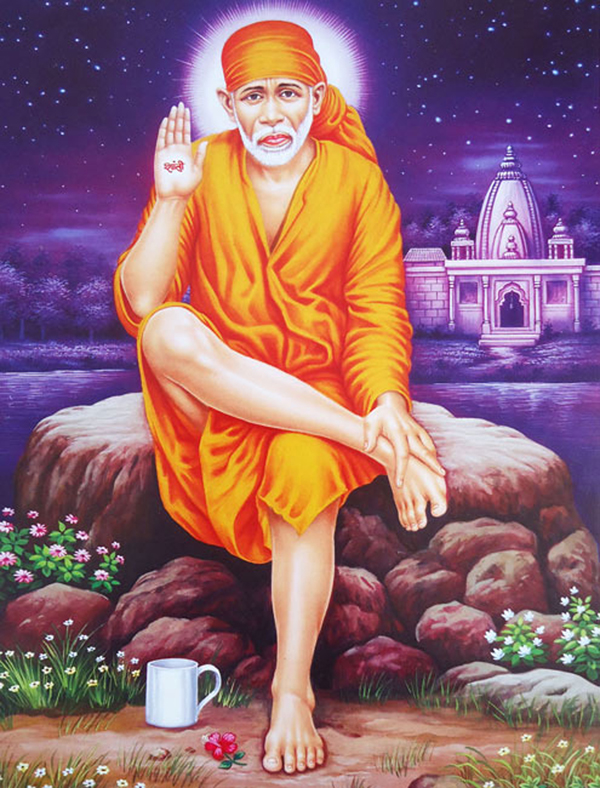Hemant Dharmat
Ramnavami, the birth anniversary of Lord Ram is very auspicious for Sai devotees as it is commemorated as the birthday of Sai Baba. No one knew when he was born as he didn’t reveal precise details of his birth. Baba, however, once said that he was born in village Pathardi and his parents hailed from Brahmin caste, who entrusted him to a Muslim Fakir at a tender age.
Large number of devotees throng Sai temples in India and abroad on Ramnavmi to pay their obeisance. After early morning-prayer known as ‘kankarh Aarti’, devotees besmear Baba’s idol with milk, curd, ghee, honey and water. Baba is then adorned with majestic mantle (‘chola’), embroidered scarf, flower garlands, gold necklace and magnificent bejeweled crown of gold. Devotees offer roses, while a few present bouquets and fresh coconut to Sai Baba. ‘Makhan-misri’ (butter-crystal sugar) and dry fruit ‘Prasad’ is distributed among the gathering. A special ‘langar’ is organized after the ‘Havan’ in which devotees whether they be rich or poor, irrespective of caste, creed, religion or region partake sumptuous meal. Most devotees enjoy day-long ‘Bhajan-Kirtan’, some meditate on Baba’s captivating ‘murti’ while others remain engrossed in “Shri Sai Sacharitara’-the book written during his lifetime that offers authentic account of events associated with Baba’s over sixty years stay in Shirdi.
At sunset, Sai ‘Palki’ is taken out with much fanfare. In 1897, Gopalrav, a devotee organized ‘Urs’ on Ramnavmi. Later on, Amir Shakkar, a Muslim devotee suggested that ‘Chandanotasav’ should also become part of the ‘Urs’. In 1911, at the initiative of Krishanrav Jogeshwar, devotees began celebrating Bhagwan Ram’s birthday alongside Urs and Chandanotsav. Decades after, the event took the shape of Baba’s birth anniversary celebrations.
Baba first appeared in Shirdi sitting under a Neem Tree at the age of barley 16 years. His countenance was that of a ‘Brahmgyani’ reflecting dispassion, stoicism and renunciation. Curious about the origin of the teenaged hermit, the villagers approached a devotee of Lord Khandoba when he was possessed by the deity, who advised them to excavate the area close to the Neem Tree. As digging progressed, a brick structure emerged under a large stone slab. When the villagers lifted the slab, they were stunned to find a room with four burning lamps inside. Lord Khandoba said that the lad had done twelve years penance at this place. Baba informed that this was his Guru’s ‘Samadhi’.The village folk restored the excavated area to its original shape by closing the passage at Baba’s request. This place is now worshipped as Gurusthan.
Once Chand Patil, a wealthy Muslim of village Doopgaon lost his mare. For couple of months he kept searching but could not trace the animal. One day he found a young fakir sitting under a tree with ‘Chilm’ in hand. The fakir struck his prong in the earth and produced an ember, with which he lighted the tobacco. Then as he stuck his ‘Satka’ on the ground, fresh water gushed forth. The fakir moistened the ‘Safi'(cloth attachment with ‘Chilm’) and started smoking. Chand Patil asked the fakir the whereabouts of his mare. The fakir advised him to search the mare towards the nearby stream. To his great amazement, as he approached the stream, he found the mare grazing in the vicinity. Chand Patil took the fakir to his house. From Doopgaon, the fakir came to Shirdi with a Barat. Mahalsapati welcomed the fakir with the words, “Aao Sai,” where-after the fakir came to be known as Sai and later as Sai Baba.
In 1910 AD, one fine day Sai Baba placed a hand-mill over a piece of sack-cloth, poured some wheat into the quern and started grinding the seeds. Baba had none to support and survived on begging from any five houses of Shirdi. Devotees present in Dwarkamai, therefore, wondered for what on earth, Baba should undertake this onerous work.But none could dare ask Sai Baba. Like wild fire the news spread in the entire village and throngs of people began pouring in ‘Dwarkamai’ with curious looks. Four daring ladies chanting Sai bhajans, ventured through the crowd, forcibly pushed Baba aside, snatched the handle of the quern from him and began grinding. At the outset, Baba became furious but realizing their devotion, he later relented. While continuing to grind, the ladies presumed that flour would be of no use to Baba as he didn’t cook his food and lived on alms. Engrossed in such thoughts, they finished grinding, divided the flour into four parts and as they readied to depart with respective share, Baba shouted, “Have you ladies, gone mad? How you dare plunder my flour. Now do as I say. Take this flour and spreadit all along the periphery of the village”.
The ladies were dumb founded and did as desired by Baba.The newcomers to Shirdi not conversant with Baba’s miracles asked the village folk about Baba’s motive behind the act.
They informed that Cholera has wrecked-havoc in Shirdi. And what everyone had then witnessed Baba grindingwas not wheat but the deadly cholera virus. Immediately afterwards, the intensity of the disease subsided and all the villagers were relieved.Human faculties, however, fail to comprehend as to what could be the material co-relation between the disease and the flour.


